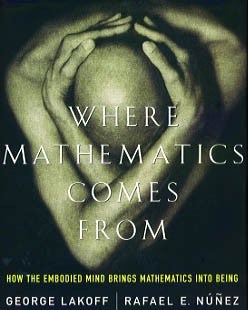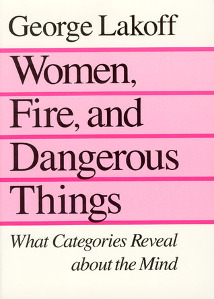
A metaphor is a figure of speech that, for rhetorical effect, directly refers to one thing by mentioning another. It may provide clarity or identify hidden similarities between two different ideas.
In linguistics, a noun class is a particular category of nouns. A noun may belong to a given class because of the characteristic features of its referent, such as gender, animacy, shape, but such designations are often clearly conventional. Some authors use the term "grammatical gender" as a synonym of "noun class", but others consider these different concepts. Noun classes should not be confused with noun classifiers.
The hypothesis of linguistic relativity, also known as the Sapir–Whorf hypothesis, the Whorf hypothesis, or Whorfianism, is a principle suggesting that the structure of a language influences its speakers' worldview or cognition, and thus people's perceptions are relative to their spoken language. Research has produced positive empirical evidence supporting linguistic relativity, and this hypothesis is provisionally accepted by many modern linguists.
Semantics is the study of reference, meaning, or truth. The term can be used to refer to subfields of several distinct disciplines, including philosophy, linguistics and computer science.
In linguistics, grammatical number is a feature of nouns, pronouns, adjectives and verb agreement that expresses count distinctions. English and other languages present number categories of singular or plural, both of which are cited by using the hash sign (#) or by the numero signs "No." and "Nos." respectively. Some languages also have a dual, trial and paucal number or other arrangements.

Where Mathematics Comes From: How the Embodied Mind Brings Mathematics into Being is a book by George Lakoff, a cognitive linguist, and Rafael E. Núñez, a psychologist. Published in 2000, WMCF seeks to found a cognitive science of mathematics, a theory of embodied mathematics based on conceptual metaphor.

George Philip Lakoff is an American cognitive linguist and philosopher, best known for his thesis that people's lives are significantly influenced by the conceptual metaphors they use to explain complex phenomena.
In cognitive linguistics, conceptual metaphor, or cognitive metaphor, refers to the understanding of one idea, or conceptual domain, in terms of another. An example of this is the understanding of quantity in terms of directionality or the understanding of time in terms of money.
Literal and figurative language is a distinction within some fields of language analysis, in particular stylistics, rhetoric, and semantics.

The modern Chinese varieties make frequent use of what are called classifiers or measure words. One use of classifiers is when a noun is qualified by a numeral or demonstrative. In the Chinese equivalent of a phrase such as "three books" or "that person", it is normally necessary to insert an appropriate classifier between the numeral/demonstrative and the noun. For example, in Standard Mandarin, the first of these phrases would be 三本书 sān běn shū, where sān means "three", shū means "books", and běn is the required classifier. When a noun stands alone without any determiner, no classifier is needed. There are also various other uses of classifiers: for example, when placed after a noun rather than before it, or when repeated, a classifier signifies a plural or indefinite quantity.

Aymara is an Aymaran language spoken by the Aymara people of the Bolivian Andes. It is one of only a handful of Native American languages with over one million speakers. Aymara, along with Spanish and Quechua, is an official language in Bolivia and Peru. It is also spoken, to a much lesser extent, by some communities in northern Chile, where it is a recognized minority language.

An image schema is a recurring structure within our cognitive processes which establishes patterns of understanding and reasoning. As an understudy to embodied cognition, image schemas are formed from our bodily interactions, from linguistic experience, and from historical context. The term is introduced in Mark Johnson's book The Body in the Mind; in case study 2 of George Lakoff's Women, Fire and Dangerous Things: and further explained by Todd Oakley in The Oxford handbook of cognitive linguistics; by Rudolf Arnheim in Visual Thinking; by the collection From Perception to Meaning: Image Schemas in Cognitive Linguistics edited by Beate Hampe and Joseph E. Grady.
Construction grammar is a family of theories within the field of cognitive linguistics which posit that constructions, or learned pairings of linguistic patterns with meanings, are the fundamental building blocks of human language. Constructions include words, morphemes, fixed expressions and idioms, and abstract grammatical rules such as the passive voice or the ditransitive. Any linguistic pattern is considered to be a construction as long as some aspect of its form or its meaning cannot be predicted from its component parts, or from other constructions that are recognized to exist. In construction grammar, every utterance is understood to be a combination of multiple different constructions, which together specify its precise meaning and form.
Cognitive semantics is part of the cognitive linguistics movement. Semantics is the study of linguistic meaning. Cognitive semantics holds that language is part of a more general human cognitive ability, and can therefore only describe the world as people conceive of it. It is implicit that different linguistic communities conceive of simple things and processes in the world differently, not necessarily some difference between a person's conceptual world and the real world.
In linguistics, definiteness is a semantic feature of noun phrases, distinguishing between referents or senses that are identifiable in a given context and those which are not. The prototypical definite noun phrase picks out a unique, familiar, specific referent such as the sun or Australia, as opposed to indefinite examples like an idea or some fish.
Cognitive rhetoric refers to an approach to rhetoric, composition, and pedagogy as well as a method for language and literary studies drawing from, or contributing to, cognitive science.
Fictive motion is the metaphorical motion of an object or abstraction through space. Fictive motion has become a subject of study in psycholinguistics and cognitive linguistics. In fictive motion sentences, a motion verb applies to a subject that is not literally capable of movement in the physical world, as in the sentence, "The fence runs along the perimeter of the house." Fictive motion is so called because it is attributed to material states, objects, or abstract concepts, that cannot (sensibly) be said to move themselves through physical space. Fictive motion sentences are pervasive in English and other languages.
Metaphor, the description of one thing as something else, has become of interest in recent decades to both analytic philosophy and continental philosophy, but for different reasons.
Experientialism is a philosophical view which states that there is no "purely rational" detached God's-eye view of the world which is external to human thought. It was first developed by George Lakoff and Mark Johnson in Metaphors We Live By. Experientialism is especially a response to the objectivist tradition of transcendental truth most prominently formulated by Immanuel Kant which still requires a commitment to what Lakoff and Johnson call "basic realism". Most importantly, this involves acknowledging the existence of a mind-independent external world and the possibility of stable knowledge of that external world. In Women, Fire and Dangerous Things, Lakoff expands on the foundations of experientialism with research into the nature of categories.
The Hopi time controversy is the academic debate about how the Hopi language grammaticalizes the concept of time, and about whether the differences between the ways the English and Hopi languages describe time are an example of linguistic relativity or not. In popular discourse the debate is often framed as a question about whether the Hopi "had a concept of time," despite it now being well established that they do.






